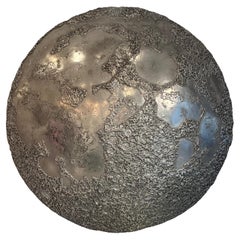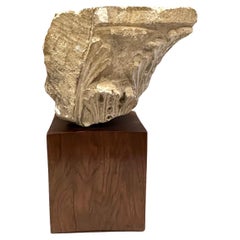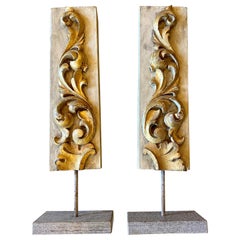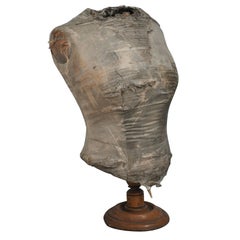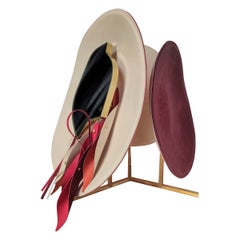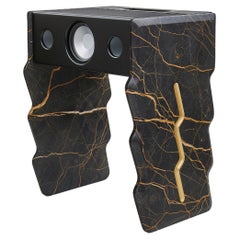French Mounted Objects
to
37
182
14
9
30
69
83
23
24
31
17
3
1
3
5
3
4
6
13
1
17
15
13
9
7
4
4
4
3
2
2
2
1
129
57
55
53
25
103
92
157,506
1,323
874
470
444
Height
to
Width
to
205
198
199
4
3
2
2
2
Place of Origin: French
Silver moon wall-mounted sculpture
Located in Saint-Ouen, FR
Michel Pichard
Silver moon wall-mounted sculpture
Edition 8/50
France
Diameter: 150 cm
Width: 20 cm
Category
2010s French Mounted Objects
Materials
Silver
19th Century Marble Capital Fragment Mounted on Wooden Base
Located in Los Angeles, CA
Hand-carved marble capital fragment mounted on a wooden base. Base: 9.5" W x 7.5"D.
Category
19th Century Antique French Mounted Objects
Materials
Marble
Pair of 18th Century Carved Fragment on Stands
Located in Vista, CA
Pair of 18th century carved fragment on stands
Wood Carved Gilt scroll acanthus leaf architectural ornamentation mounted on wood and granite stone stands.
Category
18th Century French Provincial Antique French Mounted Objects
Materials
Giltwood
$2,200 / set
Late 19th Century French Fabric Bust
Located in Wainscott, NY
Late 19th century French Fabric Bust.
Antique bust found in Paris was a shop display and is now a fantastic object with a rich and gorgeous patina.
Tur...
Category
Late 19th Century Antique French Mounted Objects
Materials
Linen
Luxury Leather Brass Table Mirror Sculpture, France
Located in Paris, FR
Firmly fixed in its base, aNa watches people, life and time."
Luxury mirror, it's a small sculpture object entirely sheathed in leather. Made up of thre...
Category
2010s French Mounted Objects
Materials
Brass
Cube Thunder Acoustic Furniture by SB26
Located in Geneve, CH
Cube Thunder Acoustic Furniture by SB26
Dimensions: W 38 x D 48 x H 52 cm
Materials: St Laurent & Arabescato marble legs, leaf gilding, leather.
Weight 25 kg.
Based on the Cube (aco...
Category
2010s Modern French Mounted Objects
Materials
Marble
$8,372 / item
Decorative Mythological Relief Plaster Panel in Gilt Color
Located in Beirut, LB
This striking and elegant wall panel is a captivating piece of mythological art. The plaster relief depicts a captivating scene of two nude female figures and a man playing a flute, ...
Category
Mid-20th Century Neoclassical French Mounted Objects
Materials
Plaster
Christian Caudron, Contemporary Sconce, Alabaster, Brass, Gilded with Fine Gold
By Christian Caudron
Located in SAINT-OUEN-SUR-SEINE, FR
Alabaster, brass and gilded gold wall lamp designed and produced by Christian Caudron, Meilleur Ouvrier de France 2015*, in his Parisian workshop.
This sconce, part of the Bridge ...
Category
21st Century and Contemporary Modern French Mounted Objects
Materials
Alabaster, Brass
One of a kind White Gold Leather Brass Copper Sculpture, France
Located in Paris, FR
White and Gold Sculpture covered with leather with its flowerbed in copper plated metal.
Hot gilding.
Its seat is in full brass, varnished and...
Category
2010s French Mounted Objects
Materials
Brass, Copper
Glass sculpture by Marc L. At Cost Price
By Marc Lepilleur
Located in Saint-Ouen (PARIS), FR
Glass sculpture by Marc Lepilleur.
France, 2015
Category
2010s Modern French Mounted Objects
Materials
Steel
1970s Agate Slice
By Jacques Duval-Brasseur 1
Located in Saint-Ouen, FR
1970s mounted agate slice on bronze and smoked Lucite base.
Great vintage condition.
Category
1970s Mid-Century Modern Vintage French Mounted Objects
Materials
Agate, Bronze
$1,783
Antique French Terracotta Plaque by Émile Müller & Co
By Emile Müller
Located in Wormelow, Herefordshire
An antique terracotta plaque depicting a horse and rider in neoclassical and roman styles by the workshops of 19th century French ceramist, sculptor and architect, Émile Müller. Poss...
Category
Late 19th Century Neoclassical Antique French Mounted Objects
Materials
Terracotta
French 1920s Zinc Pinecone Shaped Decorative Element on Circular Lucite Base
Located in Atlanta, GA
This charming French zinc pine cone shaped decorative object, hailing from circa 1920, merges the allure of nature with the refinement of vintage decor. Elegantly mounted on a circul...
Category
Early 20th Century French Mounted Objects
Materials
Zinc
Set Of 6 Long Flat Decorative Objects by Mylene Niedzialkowski
Located in Geneve, CH
Set Of 6 Long Flat Decorative Objects by Mylene Niedzialkowski
Dimensions: Between 8 and 30 cm approximately.
Materials: Raw brass.
Long flat jewelry in solid brass, handmade and de...
Category
2010s Modern French Mounted Objects
Materials
Brass
Set of 3 Particules Elémentaires Wall Sculptures by Léontine Furcy
Located in Geneve, CH
Set of 3 particules elémentaires wall sculptures by Léontine Furcy.
Unique pieces.
Materials: Rough chamotte white sandstone, and raw chamotte red oxide back.
Dimensions:
Red: L...
Category
2010s Post-Modern French Mounted Objects
Materials
Sandstone
18th Century Giltwood Sculpture of a Female Nude
By Michelangelo Buonarroti
Located in New York, NY
This giltwood sculpture was carved in the round, probably in southern France or northern Italy in the 1760s. Her pronounced musculature speaks to the ongoing influence of Michelange...
Category
Mid-18th Century Neoclassical Antique French Mounted Objects
Materials
Bronze
Mid-19th Century French Silver Torah Finials 'Rimmonim'
Located in New York, NY
Handmade silver Torah finials, chased, pierced, engraved, and cast, France, circa 1860.
The finials are constructed with large open-work decorated ball ...
Category
Mid-19th Century Antique French Mounted Objects
Materials
Silver
Mounted Marble Coat of Arms
Located in Los Angeles, CA
Hand carved marble shield with a rampant Baroque style lion in custom, later, iron 2" wide banded frame.
Category
Late 18th Century Baroque Antique French Mounted Objects
Materials
Marble, Iron
$13,500
Table Modern Lamp by Artist Salih Mehchi, Perfect for Christmas
By Salih Mekhici
Located in Alessandria, Piemonte
O/5003 - Unusual and elegant tree shaped Table led lamp, one of the first led lamp, created by the young artist Salih Mehci, very famous in France for his incredible huge lightwe...
Category
Late 20th Century Other French Mounted Objects
Materials
Steel
Pair of French Bronze Cherubs Sculptures
Located in Southall, GB
Pair of French Bronze Cherubs sculptures playing the drums. Perfect for home decor and interior design.
Category
19th Century Antique French Mounted Objects
Materials
Bronze
$926 Sale Price / set
20% Off
Pair of French Late 18th century Louis XVI Ormolu Candlesticks
Located in Worpswede / Bremen, DE
A very fine pair of Louis XVI period candlesticks of unusual form. Each with an ovoid white marble body issuing a floral spray with a flower head nozzle, supported by three curved mo...
Category
Late 18th Century Louis XVI Antique French Mounted Objects
Materials
Marble, Bronze
High Cube Thunder Acoustic Furniture by SB26
Located in Geneve, CH
High Cube Thunder Acoustic Furniture by SB26
Dimensions: W 38 x D 48 x H 62 cm
Materials: St Laurent & Arabescato marble legs, leaf gilding, leather.
Weight 30 kg.
Based on the Cube...
Category
2010s Modern French Mounted Objects
Materials
Marble
$9,062 / item
Large Antique Ceramic Wall Plaque of Military Figures
Located in Wormelow, Herefordshire
A large antique ceramic wall plaque depicting European military figures, sourced from an ex British private collection.
This unusual cera...
Category
Early 20th Century Victorian French Mounted Objects
Materials
Steel
18th Century French Millinery Head on Stand
Located in High Point, NC
18th century hand-carved walnut milliners head from France. The features are finely carved in a folk art style, and the piece is supported on a vintage base made from oak. The base...
Category
18th Century Louis XV Antique French Mounted Objects
Materials
Oak, Walnut
Jeff Koons “Lips” Porcelain Plate
By Jeff Koons
Located in Lake Worth Beach, FL
Artist/Designer: Jeff Koons (American, b. 1955); Bernardaud
Additional Information: The coupe service plate was produced in honor of Bernardaud’s 150th anniversary. The original pai...
Category
2010s French Mounted Objects
Materials
Porcelain
Recently Viewed
View AllMore Ways To Browse
Porcelain Bottle Stoppers
Printers Cabinet
Queen Wilhelmina
Rabbit Carving
Rare Seashells
Rare Swedish Kosta Boda
Regency Bow Front Chest
Renaissance Dragon
Rhino Wood
Rhode Island Furniture
Rockford Furniture
Root Wood Carving
Rose Bowl Gold
Royal Dux On Sale
Royal Insignia
Satsuma China
Satsuma Koro
Scorpion Sculpture
